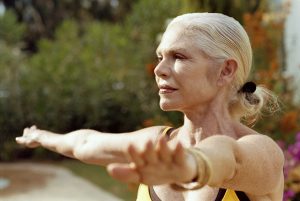
The American Heart Association recommends that people start stroke rehabilitation within seven days and continue for up to six months after a stroke. Unfortunately, many patients do not continue with rehabilitation therapy because of their physical limitations.
Physicians suggest that muscle strength training, including yoga and Tai Chi, could be beneficial for stroke survivors for improving balance, mental health, and quality of life while reducing the fear of falling because of physical implications.
Tai Chi is a traditional Chinese martial art that consists of a series of slow, careful movements of the arms, hands, neck, legs, and core. These movements are combined with deep breathing. Tai Chi can be done in a standing or sitting position. People who have had a recent ischemic stroke and have experienced partial paralysis could benefit from practicing Tai Chi in a seated position.
The recent study was conducted at two traditional Chinese medicine hospitals in China. A total of 160 adults with an average age of 63 years who had suffered their first stroke within six months of joining this study were analyzed. Half of the participants were randomly assigned to the sitting Tai Chi program, and the other half were part of the control group that practiced a standard stroke rehabilitation exercise program.
It was found that the participants who practiced seated Tai Chi exercises had improved hand and arm function and sitting balance control compared to those in the standard group. Participants in the sitting Tai Chi group also had significant reductions in symptoms of depression, and better shoulder range of motion, and showed significant improvements in activities of daily life.
Lead study author Jie Zhao explained, “Sitting Tai Chi can be practiced in a chair or wheelchair and is very convenient since it can be done in your home. The program costs almost nothing to practice, and it doesn’t require any special equipment or travel time.”
Leading Cause of Disability
According to the American Heart Association, stroke is a leading cause of long-term disability in the United States. It is also currently the 5th leading cause of death. Because of these statistics, it is vital for people to help reduce the risk of their chance of stroke. The good news is that stroke can be prevented by following healthy lifestyle habits such as getting plenty of exercises and consuming a healthy diet. Getting the proper vitamins and nutrients the body needs is also an excellent way to reduce health risks.
Heart Rescue was designed to help support and promote cardiovascular health using various ingredients. The omega-3 fatty acids found in Heart Rescue are EPA (eicosapentaenoic acid) and DHA (docosahexaenoic acid), two omega-3 essential fatty acids that play a vital role in maintaining cardiovascular health function.
CoQ10 also plays an essential role in this unique formula. It is involved in energy production at the cellular level, which can help to produce ATP. This vital energy molecule is used by the muscles in the heart as fuel to help keep it beating strong.
The overall health benefits of Heart Rescue include strengthening the heart muscle, supporting circulation, reducing the risk of heart disease, and maintaining healthy cholesterol. Include Heart Rescue in your daily routine to help maintain your cardiovascular health.